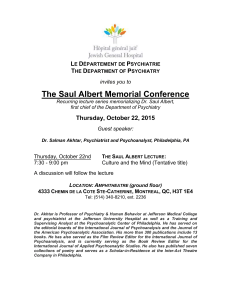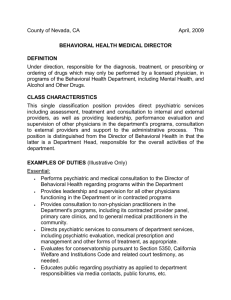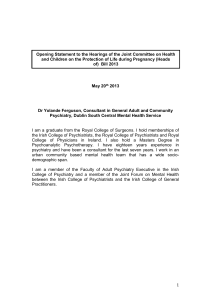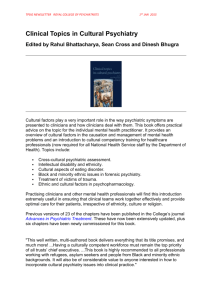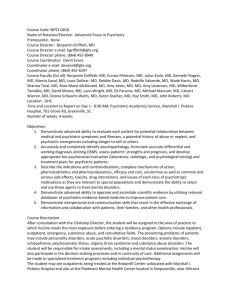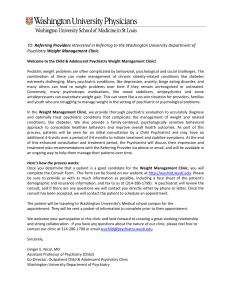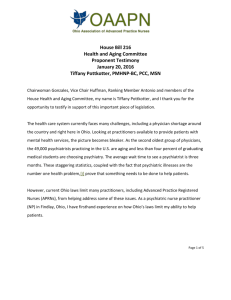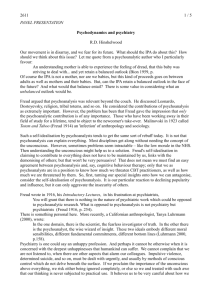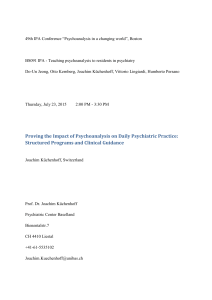Alliance, Collaboration and Fruitful Divergences between
advertisement
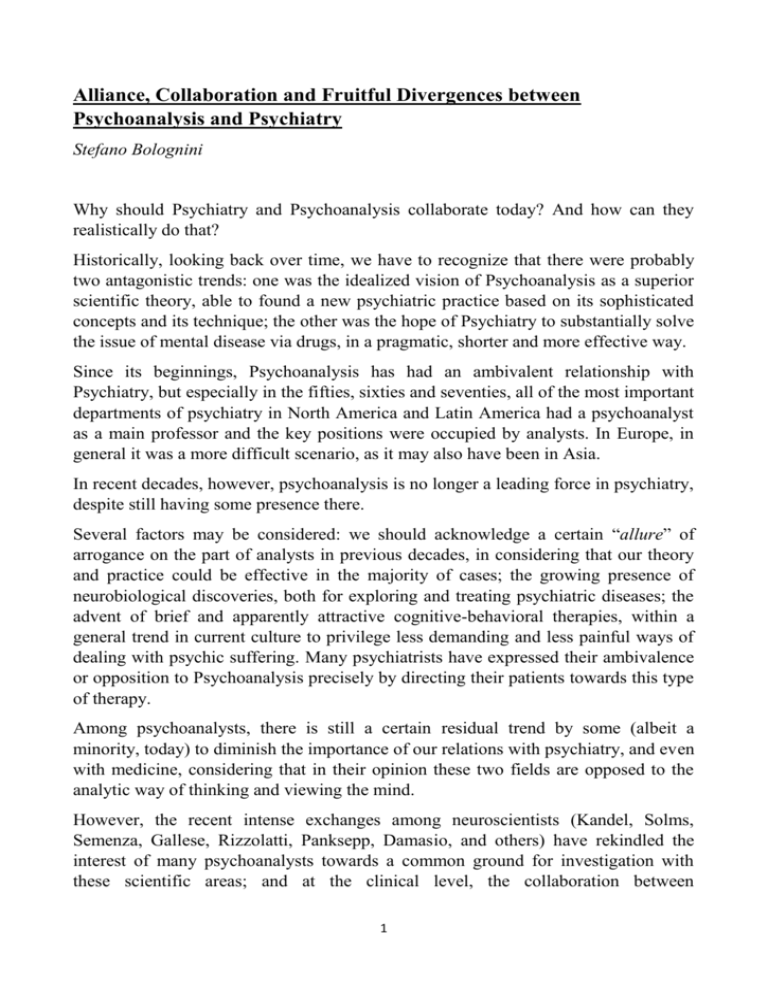
Alliance, Collaboration and Fruitful Divergences between Psychoanalysis and Psychiatry Stefano Bolognini Why should Psychiatry and Psychoanalysis collaborate today? And how can they realistically do that? Historically, looking back over time, we have to recognize that there were probably two antagonistic trends: one was the idealized vision of Psychoanalysis as a superior scientific theory, able to found a new psychiatric practice based on its sophisticated concepts and its technique; the other was the hope of Psychiatry to substantially solve the issue of mental disease via drugs, in a pragmatic, shorter and more effective way. Since its beginnings, Psychoanalysis has had an ambivalent relationship with Psychiatry, but especially in the fifties, sixties and seventies, all of the most important departments of psychiatry in North America and Latin America had a psychoanalyst as a main professor and the key positions were occupied by analysts. In Europe, in general it was a more difficult scenario, as it may also have been in Asia. In recent decades, however, psychoanalysis is no longer a leading force in psychiatry, despite still having some presence there. Several factors may be considered: we should acknowledge a certain “allure” of arrogance on the part of analysts in previous decades, in considering that our theory and practice could be effective in the majority of cases; the growing presence of neurobiological discoveries, both for exploring and treating psychiatric diseases; the advent of brief and apparently attractive cognitive-behavioral therapies, within a general trend in current culture to privilege less demanding and less painful ways of dealing with psychic suffering. Many psychiatrists have expressed their ambivalence or opposition to Psychoanalysis precisely by directing their patients towards this type of therapy. Among psychoanalysts, there is still a certain residual trend by some (albeit a minority, today) to diminish the importance of our relations with psychiatry, and even with medicine, considering that in their opinion these two fields are opposed to the analytic way of thinking and viewing the mind. However, the recent intense exchanges among neuroscientists (Kandel, Solms, Semenza, Gallese, Rizzolatti, Panksepp, Damasio, and others) have rekindled the interest of many psychoanalysts towards a common ground for investigation with these scientific areas; and at the clinical level, the collaboration between 1 psychoanalysts and psychiatrists has intensified within the Mental Health field services. On the other hand, it has decidedly decreased at the University level. The teaching of psychoanalysis in psychiatric institutes has gradually decreased even if, at the same time, in many places, young psychiatrists are increasingly interested in psychoanalysis, residents are seeking supervision, and several patients no longer accept drug-only treatments, feeling the need for a better understanding of their personal difficulties. In fact, we have the strong feeling that the relationship between psychoanalysis and psychiatry needs to be rediscovered, explored, restructured and strengthened, both at a scientific and at an institutional level. After having practiced for years in both fields, I can confirm how historically both integralist psychoanalytic and psychiatric visions and approaches alternated for decades, with underlying ideal omnipotent illusion, supported by the narcissistic ambitions of the two professional groups, in an implicit atmosphere of competition and rivalry. More realistically, a collaboration today seems to be both possible and desirable, with mutual advantages, through the recognition of the specific competences and limitations of each discipline. In my presentation, I want to emphasize and to explore some fundamental issues: The change in contemporary pathology treated all over the world by psychoanalysts and psychoanalytic therapists: nowadays, rather than the historically usual neurotic patients (the so-called “Viennese” patients that are so rare today…), we are dealing more and more with borderlines, personality and narcissistic disorders, severe depressions and psychoses; so that pharmacological support (sometimes with episodic hospitalization) is frequently needed for long periods in some treatment. In several cases of severely ill patients, the analyst has to rely on the collaboration of a psychiatrist for handling and holding the anxieties of the patient’s entire family. It is very rare that the primal difficulties of separation involve only the patient and the family frequently needs some external support, which permits the working through of the patient-analyst pair. Many symbiotic family relationships cannot allow the progress of a patient in treatment when that produces changes in the family’s 2 unconscious organization. In such cases, the psychiatrist acts as a sort of “analytic third” able to protect the difficult process promoted by psychotherapy. Sometimes the presence of the psychiatrist in that family scene is important not only for his/her regulatory and separating function, which allows the patient in analysis to go ahead with his treatment in spite of the symbiotic family opposition; but also since the psychiatrist works as a libidinally and affectively invested alternative object, which can attract and bind a small but strategic part of the libido of the symbiotic family members. In short, he creates a new object that can solve and contain a part of the separation anxieties of those who are not in treatment. In the past, it was usual to say that psychiatrists-psychoanalysts were much more familiar with severe pathologies, less scared by those symptoms and more equipped for facing them; while psychologists-psychoanalysts were more theoretically cultured in general but unable to deal with dramatic serious breakdowns and major psychopathological syndromes. Fortunately and opportunely, psychoanalytic training today must include a period of practice in a psychiatric service, in order to provide future psychoanalysts with direct experience of (and some familiarity with) severe pathological illnesses and their specific phases and vicissitudes. Furthermore, contemporary analysts have improved their knowledge about the dynamic aspects and mechanisms of dissociative states, hallucinatory mental functions, delusional defensive organisations and narcissistically deprived conditions of the Self; their familiarity with such primitive or altered mental states allows them today to effectively collaborate with the psychiatric teams. On the other hand, a number of experienced psychoanalysts are asked for supervisions in the Mental Health Service sectors in many countries, even if this often happens in an unofficial and institutionally conflictual way. It should be made clear that their work is not aimed at planning the psychoanalytic treatment of patients, but mainly at working through and improving the emotional environment of the psychiatric équipes, which are generally affected by the resonance of pathological impacts and influences generated in the institutional field. So, one of the main contributions of psychoanalysts to the Mental Health field today is related to supervisions and working through of the experiences of the psychiatric working teams. 3 For decades, analysts in many countries have been collaborating with psychiatric équipes by intensively exploring and sharing their direct experiences and contacts with their patients and with their pathologies, as well as with the context that hosts their consultations, hospitalizations and treatments. The main overarching goal of this work is to “give sense to what may seem senseless” in the daily interaction with their patients, when possible, and to improve the “liveability” of the interpsychic institutional environment. It is worth repeating that this practice, therefore, does not involve psychoanalyzing a patient in the institution at all; instead it involves using the psychoanalytic view of the mind, the group, the person and the relationship to help the operators to work in a very different way from the psychic "non-working" by which many individuals and groups tend to unconsciously defend themselves from anxiety (mainly in order not to contact their own feelings). It is interesting to note that in many countries these supervisions are administratively registered and regularly paid by the National Health Systems, but they frequently appear to be unofficial and almost secret, more or less as if the team that requested the supervisions should behave like a private patient, needing some confidentiality. Anyway, I have no hesitation in stating that this profound, continuous and extensive (albeit unacclaimed) work within the équipes, carried forward for decades with such dedication by analysts and psychiatrists in joint collaboration, has contributed to bringing about considerable changes in psychiatry. There have been internal changes among doctors, psychologists, social workers, and above all nursing staff, who are now able in many cases to think, feel, communicate and interact with each other and with their patients by elaborating fantasies and emotional states that were previously unthinkable (or at least unmentionable), in a process of gradual humanization and familiarization with the inner world and its most perturbing paths. In essence, the contribution of psychoanalysis to groups working in the institutional environment today has neither a Super-Ego style (= "this is the way it should – or shouldn’t – be done!"), nor a narcissistic oracle style (= "the analyst-guru"): instead its contribution is creative and sometimes reparative, cultured and patient, based on a shared construction of the sense and discovery of the experience, the fruitful germination of thought under initially arduous conditions, and the transformation of the unthinkable into the ''at least partially thinkable and communicable". Above all, I would say that we have moved progressively from "supervision" to "inter-vision". 4 I see this “work in progress" as another step forward in the fight against the alienation of thought and feeling in institutions; and our expectation is that these shared experiences can help young people working in the Mental Health field to understand that there is a psychiatry that espouses psychoanalysis without imitating it, but also without fearing it; and vice versa. I will now mention some notes on specific clinical problems that can occur when some patients are treated differently and separately by the two professionals, with no mutual communication: i.e. some cases of underestimated seriousness of depression or of psychotic breakdown, where the analyst doesn’t realize how helpful, or frankly necessary, pharmacological support could be; or vice versa, cases of natural, painful mourning for human losses where the psychiatrist may be too quick to prescribe drugs, while a physiological, necessary internal process of mourning could be at stake. In such situations, a mutual consultation between the two professionals would be extremely helpful, and the two could integrate their specific visions, for the benefit of the patient. In our practice today, much more than in the past, we are working with patients that are very different from one other: i.e., we deal with those patients that would have been defined as “psychotics” by analysts but not by psychiatrists; these are often patients who widely utilize psychotic defenses and psychotic-style mental functioning, but who maintain, on the exterior, a socially acceptable attitude, one that is, all things considered, compatible with a semblance of normality. (This will be illustrated through the presentation of a specific clinical case during the panel.) In other cases we deal with patients that – by common consent – are quite frankly and evidently in need of psychiatric assistance and attention across the board; and in some other cases with those who had initially been classified as psychiatric psychotics, who vice versa are able sometimes to achieve a calm and effective neuroticism after years of courageous and tenacious analytic work. In other words, people whose ego functioning had undergone notable and evident changes at different times. As a curious example of shared work with psychiatrists during an équipe "Intervision", I will mention a rather unsettling episode that occurred within the institutional context. 5 (Here another clinical case will be presented during the panel.) Finally, I want to dedicate some short notes to two psychoanalytic concepts apt to the psychiatric organization: 1) containment 2) constancy of the object. Regarding containment, some historical biases connected with this concept should be examined, since they sometimes impede a fundamental functioning of institutional work. To contain is a basic task of the institution when it is necessary; and in such cases that function should not generate a feeling of guilt in the caregiver. I think that the psychiatric world can be helped by psychoanalysts to evaluate in greater depth, in a suitably responsible way and without attributing blame socially, the necessary function of containing seriously ill patients, when they pose a potential danger to themselves or to others, when they are extremely regressed or appear to be on the verge of a critical breakdown. Naturally, the quality of this containment is of vital importance: the good container facilitates the recovery of adequate mental functions and is not limited to physical containment; however, the latter should not be demonized when it is really necessary, and in this sense it can also be useful to encourage a cultural reflection on the fact that in some cases it is wrong to "close in" certain patients, as was the case in the past of our institutions; but in other cases it is equally wrong to "close them out", remaining deaf to the primary need for containment. Regarding constancy of the object, the basic need to find and recognize the object/caregiver, and the patient’s relationship with it, implies a special attention in the Mental Health service to providing highly disturbed and severely regressed patients with continuity in assistance from the same operators (a need that is frequently unrecognized or overlooked in the institutional organization). Particularly in the eighties and nineties, a political myth of interchangeability of the Mental Health operators became dominant in many countries, based on the idea that no special link between the patient and the caregivers should create dependence. The psychoanalytic experience valorizes the opposite: the personal link, that generates familiarity, is a potential factor of internal reparation of previous traumatic ruptures, through a consistent relationship. But this last note should be discussed mainly with the Mental Health administrators, more than with the psychiatrists who so frequently regret, concurring with us, the 6 serious lack of continuity in their psychiatric work organization, due to political decisions that have nothing to do with deeply reflected technical choices. 7
